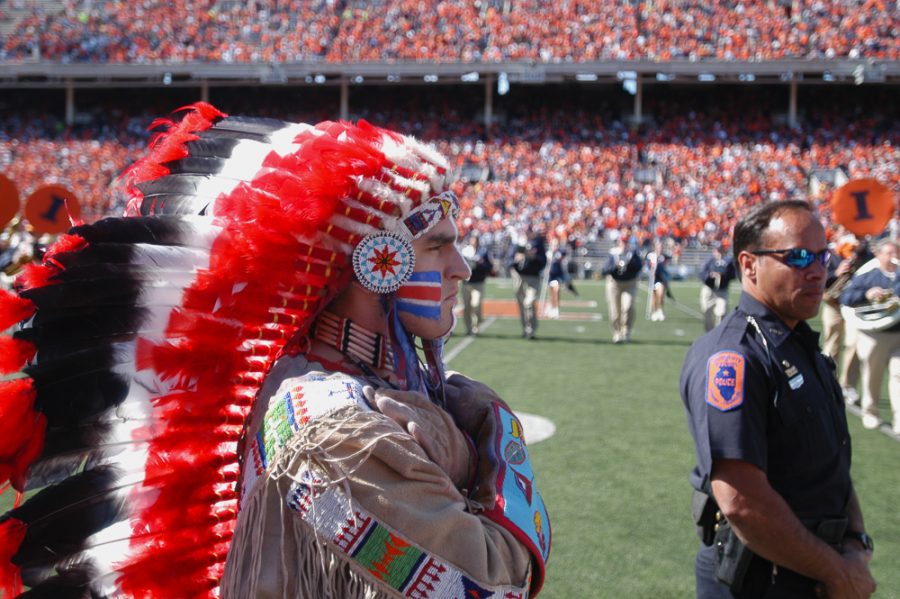Illini Republicans will hold a “Meeting With the Chief” later this month
Former University mascot Chief Illiniwek performs at the halftime show in a football game on Oct. 7, 2006. The Chief was retired by the University in 2007 amid controversy. Illini Republicans is hosting Ivan Dozier who portrayed the Chief, later this month
Oct 12, 2017
On Oct. 26, the Illini Republicans’ weekly meeting will feature a guest – Ivan Dozier, who portrayed Chief Illiniwek from 2010 to 2015 – for a “Meeting with the Chief.”
Dozier graduated from the College of ACES in 2013 and completed his master’s in the same school in 2015. He is only the second person with a Native American background to portray the Chief since the mascot first appeared in 1926. Dozier is currently a member of the Council of Chiefs and a board member of the Honor the Chief Society.
The Council of Chiefs is a group of alumni who used to portray the Chief. They are responsible for selecting the next Chief.
The Honor the Chief Society, according to its Facebook page, was founded in 2001 to lend historical perspective to the Chief Illiniwek tradition at the University.
“(The meeting) is probably going to be pretty brief… just a general history about the Chief, how it was started, how it was carried out, why it was retired and the current struggles that we have here on campus,” Dozier said.
Get The Daily Illini in your inbox!
The meeting will primarily be an attempt to educate attendees about the controversy, and Dozier will leave time for questions.
Dozier initially contacted Turning Point USA at the University, who were campaigning on the Main Quad to bring the Chief back on Sept. 27. Some members of the group were also members of the Illini Republicans.
Dozier got into contact with the Illini Republicans and set up the meeting through them.
“I know the community around us really supports the Chief,” said Jonathan Heideman, senior in LAS and president of the Illini Republicans, said. “We’re Republicans. “We’re hoping he’s very inspirational.”
Thereza Lituma, junior in FAA and member of the Native American and Indigenous Student Organization on campus, does not share Dozier’s and Heideman’s enthusiasm.
“I think that having people continue to portray the Chief has continued this really hostile campus climate,” she said. “It has divided a lot of groups, it makes people feel that they have to pick a side.”
Lituma said while some members of NAISO are outspoken against the Chief, others are unsure about how to approach the issue.
“We’re all college students, a lot of us are not trained to be fighting in this really hostile campus climate,” she said.
Lituma said she wasn’t surprised when she saw the event was happening.
“I’ve noticed throughout the years that organizations for the promotion of the former mascot have become very outspoken,” she said.
Lituma and other members of NAISO will not be attending the “Meeting with the Chief.”
“I don’t know what will happen at the event,” Lituma said. “I don’t want to put me or my members in a position where the words or feelings we have will be twisted and used against us.”
She also said the Chief and movements supporting it have made situations difficult for her and her friends over the years, because the Native imagery and nostalgia for it have a negative effect on their identity formation and native education.
“I just want to make sure that this meeting with the Chief doesn’t distract from things like working towards Indigenous People’s Day and standing in solidarity with Standing Rock,” Lituma said. “Our organization is very focused on other issues right now. In order to move forward, Native education has to be promoted on this campus.”
Both Lituma and Dozier, on either side of the controversy, are extremely critical of the administration’s position on the Chief.
Lituma said there hasn’t been much cultural education since the removal on why the University made that decision, or how it impacts Native communities, the campus climate and other communities, since the University is a member of the Big Ten.
“That lack of commitment really says a lot. It says that they are hesitant on where their morals lie for this institution,” she said.
Lituma also said that despite talks and reassurances about diversity and inclusion, “with real difficult subjects (the administration) seems to become quiet all of a sudden. I don’t know what they think because I don’t see action.”
Dozier said he believes that the Chief was retired because the University panicked, and did not handle the retirement properly.
“It was hasty, it was poorly executed … we’re going to continue to face divisiveness on this campus,” Dozier said. “The way in which the Chief was retired was not a well thought out decision and we’re still facing the repercussions of the decision now.”
He also said the current administration is in over their heads.
“They are restricting themselves to only a certain point of view,” he said. “If we’re truly going to move forward, we need to have a seat at the table for every stakeholder at this university, not just one side,” he said.






